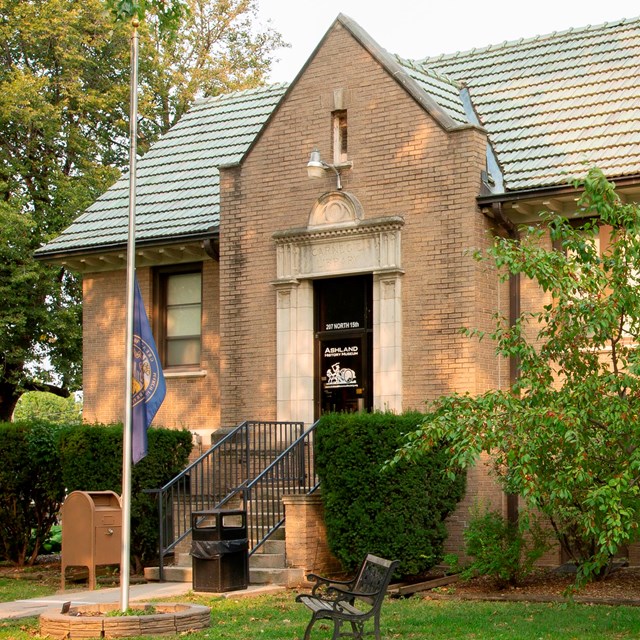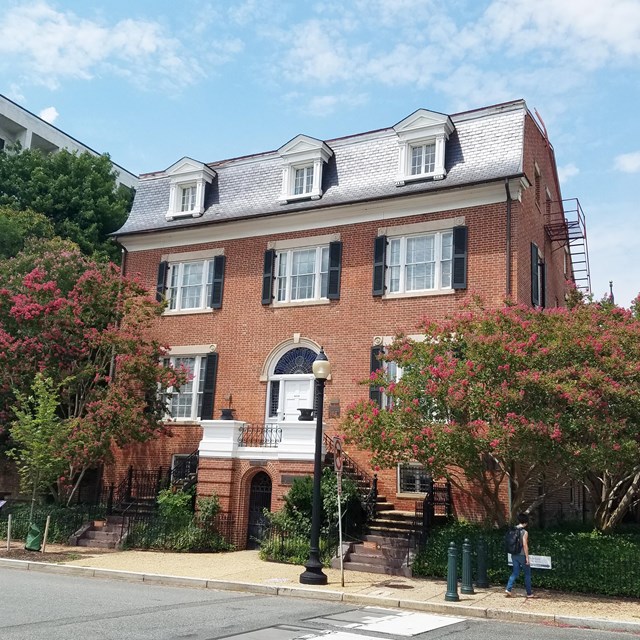Last updated: July 24, 2024
Article
Historic Preservation Fund Apportionment Update
Revisions to the State Historic Preservation Office Annual Apportionment Formula
The Historic Preservation Fund (HPF) was established in 1977 to support the work of the National Historic Preservation Act (54 USC 300101 et seq.). Each year, through 2023, $150 million is deposited into the fund from offshore oil and gas lease revenues. Originally the funding was intended for just states but later grew to include local governments (1980s), tribal nations (1990s), and competitive grant programs. Funds for these programs are appropriated annually by Congress.
Funds to states are awarded according to an apportionment formula that provides funding based on need as determined by the Secretary of the Interior. In July 2022, the National Park Service published revisions to the apportionment formula following a comprehensive review of the formula that had been in place since 2002. Revisions to the formula were based on recommendations developed by the National Park Service Cultural Resources, Partnerships, and Science Directorate (CRPS) following an extensive research and stakeholder engagement process between 2020 and 2022. The NPS Director approved the revisions in July 2022 in accordance with the Department of the Interior Departmental Manual Part 245, Chapter 1.1.C(15) which authorizes the director to "administer the Historic Preservation Fund program" on behalf of the Secretary of the Interior.
Implementation of Apportionment Formula Revisions in Fiscal Year 2023
The revised state apportionment formula will be implemented in fiscal year 2023 as directed by Congress in the Explanatory Statement for the Consolidated Appropriations Act of 2023 (PL 117-328) (PDF). This formula will be used until a new census or future revisions to the formula are made. Revisions reflect an increase in the base award for all states and the use of the current census data for tiers 2 and 3. The apportionment formula is composed of the following components:
- Tier 1 Base Award of equal division; all SHPOs will receive a base amount of $400,000, with a percentage set aside for the Freely Associated States;
- Tier 2 Census Award will be based on 2020 US Census data factors for acreage, population, and number of residential structures over 50 years old;
- Tier 3 Statute Award (54 USC 302902(c)(4)) will allocate appropriations above $65 million by applying Tier 2 US Census calculations and, by statute, requiring each state to award 50% of that calculated amount to its Certified Local Government partners.

On October 27, 2022, NPS presented an update to State Historic Preservation Offices regarding updates to the apportionment formula. Slides from the presentation are linked below for reference. Please note that these slides will not reflect the fact that NPS was directed by Congress to implement the formula in fiscal year 2023, not 2024.
Frequently Asked Questions
About the State Apportionment Formula
The Historic Preservation Fund’s annual formula grants are awarded to 59 State Historic Preservation Offices in each of the 50 states, the District of Columbia, the five US territories, and 3 Freely Associated States.
The National Historic Preservation Act requires states pass through at least 10% of their annual Historic Preservation Fund grant award to Certified Local Governments. Additionally, once the appropriation to the states exceeds $65 million, the National Historic Preservation Act requires half of the excess funding be made available to Certified Local Governments. Currently there are over 2,080 Certified Local Governments across the country.
Under the National Historic Preservation Act, the state apportionment formula is determined by the Secretary of the Interior, through the National Park Service, based on the needs of all states.
The current formula (effective FY2023) for determining annual SHPO apportionments for the 50 states, District of Columbia, and US territories has three tiers:
- Tier 1 Base Award of equal division; all SHPOs will receive a base amount of $400,000, with a percentage set aside for the Freely Associated States;
- Tier 2 Census Award will be based on 2020 US Census data factors for acreage, population, and number of residential structures over 50 years old;
- Tier 3 Statute Award (54 USC 302902(c)(4)) will allocate appropriations above $65 million by applying Tier 2 US Census calculations and, by statute, requiring each state to award 50% of that calculated amount to its Certified Local Government partners.
Changes to the State Apportionment Formula
A comprehensive review of the State Historic Preservation Office apportionment formula was undertaken by the National Park Service to result in equitable revisions while using consistent data as provided by the US Census. The state apportionment formula will be implemented in federal fiscal year 2023 using 2020 Census data and remain in effect until the next census or next review of formula.
Changes to the apportionment formula, below, may result in increases or decreases in total awards due to the shift to current census data.
-
Tier 1: Beginning in FY2023, there will be an increase in the base award amount from $357,143 to $400,000 per state (an overall increase of $2,399,992).
-
Tier 2: Using the same data factors as before (acreage, population, and the number of residential structures over 50 years old), calculations will be updated using 2020 Census data.
-
Tier 3: When state appropriation level exceeds $65 million, Tier 2 Census calculations will be apply and each state required to award 50% of that calculated amount to its Certified Local Governments.
Note: Because the Freely Associated States do not have the same Census data sets, their awards will remain based on the same percentage of the total apportionment they received in FY21.
-
In accordance with Section 103 of the National Historic Preservation Act, as amended, the apportionment formula constitutes the Secretary’s determination of “need” for the states.
-
The National Park Service will use the apportionment formula to define “need” and avoid subjectivity.
-
Any annual Historic Preservation Fund funding is subject to Congressional appropriations language that may provide additional requirements on how funding is distributed and spent.
-
The apportionment formula should be as logical and simple to explain as possible.
-
The apportionment formula must be equitable to every State.
-
Every state requires a base allocation to run a program that meets minimum federal requirements.
-
The apportionment formula needs to be independently numeric and calculable.
-
The formula should be dynamic, moving forward with adjustments as needed and warranted, taking into consideration no random/sporadic changes, and substantive changes will be made with consultation.
-
As much as possible, each state’s award amount should be predictable to allow each state to plan accordingly.
-
Any formula modifications should be implemented in a way that minimizes disruption to state programs.
-
Modifications to the formula must consider potential impacts to Certified Local Governments.
-
The impacts of the Historic Preservation Fund annual allocation reaching the $65 million statutory threshold must be a focus area for the National Park Service. A proposed plan will be developed by the National Park Service to address the changes that will be required once the $65 million threshold is reached and exceeded.
State Historic Preservation Offices and Certified Local Governments were given the opportunity to provide comments to the current formula and suggest revisions via surveys. Input was received from 87% of State Historic Preservation Offices surveyed, with the majority indicating that they were satisfied with the current data points and the formula should regularly be reviewed and updated. Responses from Certified Local Governments were received from across the country broadly, and overall were supportive of the process with recommendations to streamline their ability to receive CLG grant funding through their state offices. The National Park Service reviewed the survey results in detail and is working to implement several of the suggestions and recommendations that fall outside of the formula itself.
For example, your state probably increased in population and structures. This is an easy assumption because only 6 states and territories did not increase in population and only 4 territories did not increase in structures since 2000. However, 36 states and territories did not increase in population over the national average and 31 states and territories did not increase in structures over the national average.
About the Historic Preservation Fund
The National Park Service’s State, Tribal, Local, Plans & Grants Division manages three types of grant programs funded by the Historic Preservation Fund:
-
Formula grants are awarded annually to State Historic Preservation Offices and Tribal Historic Preservation Offices based on apportionment formulas. These appropriations provide essential operational funding for these organizations to maintain their role in the federal preservation partnership program and fulfill their duties assigned in the National Historic Preservation Act. At least 10% of state appropriations are given to Certified Local Governments as subgrants for projects of local importance.
-
Competitive grants may be appropriated by Congress to provide financial assistance to support historic preservation projects that range from physical preservation work to preservation planning, education, survey, and documentation for historic sites. Currently there are eight annual competitive grant programs, including the African American Civil Rights, History of Equal Rights, Historically Black Colleges and Universities, Paul Bruhn Historic Revitalization Subgrants, Save America’s Treasures, Semiquincentennial, Tribal Heritage, and Underrepresented Communities grant programs.
-
Disaster recovery grants provide emergency funding to assist communities with preservation and repair work at historic sites when appropriated by Congress.
The Historic Preservation Fund supports the work of state and tribal historic preservation offices in carrying out the responsibilities delegated to them by the Department of the Interior and the National Historic Preservation Act, including:
-
Nominating properties to the National Register of Historic Places
-
Administering the Historic Tax Credit program
-
Reviewing Federal undertakings for impacts to historic properties
-
Survey and inventory of historic properties, development (e.g., physical preservation)
-
Creation of preservation plans
-
Assisting Certified Local Governments with preservation of local resources
-
Administration of federal grant programs
Historic Preservation Fund Supports
-
 Formula Grants to States
Formula Grants to StatesThe Historic Preservation Fund invests in states and territories, the District of Columbia, and the Freely Associated States.
-
 Grants in Local Communities
Grants in Local CommunitiesWhile states must give funding from formula grants to local communities, HPF also supports grants local governments can directly apply for.
-
 About the Historic Preservation Fund
About the Historic Preservation FundAdditional information about the Historic Preservation Fund, including annual accomplishments and statistical reports
